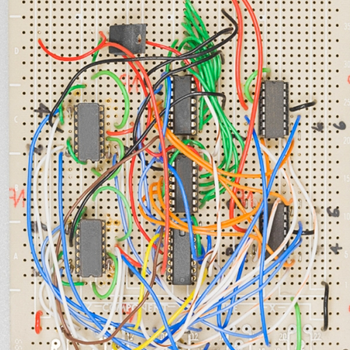x^4+1 is not able to be factorized in rationals.
However, like x^4+4=(x^2+2)^2-(2x)^2=(x^2+2x+2)(x^2-2x+2), you can factorize x^4+1 in reals:
x^4+1=(x^2+1)^2-(sqrt(2)x)^2=(x^2+sqrt(2)x+1)(x^2-sqrt(2)x+1)
Note that x^2+-sqrt(2)x+1=(x+-sqrt(2)/2)^2+1/2 ・・(A) cannot be factorized in reals anymore.
Thus, 1/(x^4+1) can be rewritten in partial fractions form:
1/(x^4+1)=(ax+b)/(x^2+sqrt(2)x+1)+(cx+d)/(x^2-sqrt(2)x+1)・・(B)
(a,b,c,dinRR)
What we want to do is to find a,b,c,d so that (B) is an identity.
Multyply both sides by x^4+1 and you find
1=(ax+b)(x^2-sqrt(2)x+1)+(cx+d)(x^2+sqrt(2)x+1)
1=(a+c)x^3+(-sqrt(2)a+b+sqrt(2)c+d)x^2+(a-sqrt(2)b+c+sqrt(2)d)x+(b+d)
Make a comparison of coefficients and you will see:
a+c=0 (i)
-sqrt(2)a+b+sqrt(2)c+d=0 (ii)
a-sqrt(2)b+c+sqrt(2)d=0 (iii)
b+d=1 (iv)
By (i) and (iv) you can easily see:
c=-a, d=1-b
Substitute these in (ii) and (iii):
-2sqrt(2)a+1=0, -2sqrt(2)b+sqrt(2)=0
a=sqrt(2)/4, b=1/2, c=-sqrt(2)/4, d=1/2
We have completed to simplify (B) and got to the start line.
color(blue)(1/(x^4+1)=(sqrt(2)/4x+1/2)/(x^2+sqrt(2)x+1)+(-sqrt(2)/4x+1/2)/(x^2-sqrt(2)x+1))
Now let's go to the next stage: integration.
Since d/(dx)(x^2+sqrt(2)x+1)=2x+sqrt(2) and sqrt(2)/4x+1/2=sqrt(2)/8(2x+sqrt(2))+1/4,
int((sqrt(2)/4x+1/2)/(x^2+sqrt(2)x+1))dx
=sqrt(2)/8int(2x+sqrt(2))/(x^2+sqrt(2)x+1)dx+1/4int1/(x^2+sqrt(2)x+1)dx
=sqrt(2)/8ln(x^2+sqrt(2)x+1)+sqrt(2)/4arctan(sqrt(2)x+1)+C.
Note that color(green)(int1/((x+p)^2+q^2)dx=arctan((x+p)/q)/q) for q>0. Here, p=q=sqrt(2)/2 (See (A)).
In similar ways (this will be a good excercise to show this^^),
int((-sqrt(2)/4x+1/2)/(x^2-sqrt(2)x+1))dx
=-sqrt(2)/8ln(x^2-sqrt(2)x+1)-sqrt(2)/4arctan(-sqrt(2)x+1)+C.
Sum up the two integration and you will finally acheived the goal:
color(red)(int1/(x^4+1)dx=sqrt(2)/8ln((x^2+sqrt(2)x+1)/(x^2-sqrt(2)x+1))+sqrt(2)/4(arctan(sqrt(2)x+1)-arctan(-sqrt(2)x+1))+C).

